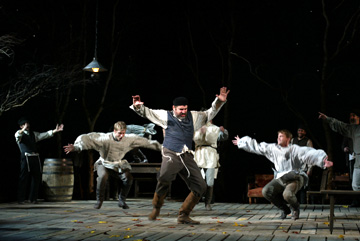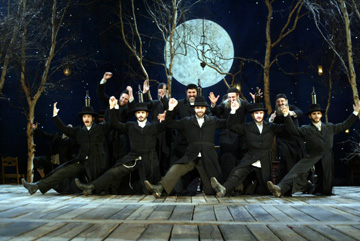Fiddling with Tradition
Fiddler
on the Roof
Directed by David Leveaux; Musical staging by Jonathan Butterell
Minskoff Theatre
New York, NY
March 3, 2004
by
Susan Reiter
copyright 2004 by Susan Reiter
published 15 March 2004

David Leveaux, the accomplished British director who last year radically rethought the 1982 musical Nine, has taken charge of Fiddler and subtly altered the tone, lessening its robustness and gusto. The many strongly delineated major and lesser characters remain very much who they are, and the show's strong outline does not allow for much creative tinkering. But aside from the times when the fervent dancing, which comes across as a spontaneous expression of who these people are, takes over, the community of Anatevka—the deep bonds between its populace—does not express itself as potently or dynamically as in the past,
This is also the first New York revival of this timeless, touching musical not to feature the set designs of Boris Aronson, who contributed so powerfully to the brilliant original production. Two concentric turntables were a major feature of his sets, along with evolving Chagall-inspired backdrops and a believably rustic simplicity of the interiors. The exposed stage one finds upon entering the cavernous Minskoff Theatre offers a surprising scene. A large, slightly raked rectangle, seemingly of rough-hewn wood, is surrounded by open areas at the side and delicate, stark birch trees upstage. Lanterns hang from the trees, and behind them is an open area that can be shaped and re-defined by screens and scrims. A large, worn partial frame of a roof hangs above.

For Fiddler, Robbins did what he had done as show doctor for Stephen Sondheim's 1962 show A Funny Thing Happened on the Way to the Forum: came up with the idea for the perfect opening number that would set the scene for what was to come, inviting the audience to settle in and come along for the wonderful ride. "Tradition" still launches the show headlong into its tale of how shifting values and political circumstance will test the power of traditional ways. As "Tradition" winds down, Tevye speaks of the "Little circle of our village," and without the all-important circles that Robbins and Aronson built into the show, the number is not as organically connected to the overall picture.
A lot of very specific intention went into that conception of the show and its circular momentum. According to the chapter on Fiddler in the 1987 book The Theater Art of Boris Aronson, by Frank Rich with Lisa Aronson, "Robbins was also struck by the visual image of a circle, which suggests both the notion of a tight community and the patterns of folk dancing. Robbins used a circular formation for his choreography of "Tradition," and two acts later, he ended the musical with the breaking up of that communal circle, to symbolize the dispersal of the Jews who were forced out of Russia by pogroms."
Leveaux has created a very picturesque production, with the Fiddler (portrayed by Nick Danielson, of the New York City Ballet Orchestra) seeming to offer silent commentary on the action with his frequent appearances at the edges of the action. The shadowy figure of a small boy accompanies him, standing by or occasionally being sent on an apparently aimless walk across the stage or around its perimeter. Necessary pieces of furniture or props are brought on swiftly as needed, without a break in the action between scenes, and removed just as seamlessly. There is a rough-hewn quality to the overall stage picture and this way of setting the scene, which is appropriate to the simple lives being depicted. But often, especially at the end of scenes, it seems that Leveaux has contrived a lovely picture for its own sake, rather than heeded the impulse of the story.
The lanterns light up as part of an overly obvious lighting shift that occurs when Tevye has his wry, skeptical conversations with God. These moments are not the ones when Molina, who makes Tevye a fully developed but less imposing figure than others have, seems most comfortable with his character. He does not convince us that Tevye has an ongoing running debate with this higher power, that it is part of how he copes and survives whatever befalls him and his family. He does convey Tevye's humor and humanity, and his confrontations and conversations with his family members and neighbors have a very natural spontaneity and believability. He sings with a somewhat raspy voice, injecting a strong sense of character into the material but not using his vocal power in a dominating manner.
Randy Graff makes Golde, his wife, a less shrewish, and younger, figure than in past productions. Her somewhat bullying and business-like manner with her husband reflects a longstanding marriage and the demands of raising five children, but she conveys the fundamental affection underneath. Surprisingly, since she is one of the most talented and interesting musical theater performers of the past decade, her singing here seems off, as though she is straining to reach a key that is not comfortably in her range.
Robbins' sure touch is evident in the heartfelt simplicity of the wedding scene, which includes "Sunrise, Sunset" and leads into the ecstatic men's dancing than suddenly quiets for the spellbinding Bottle Dance, before the line of demarcation is crossed and male-female couples begin to dance together with increasing exhilaration. The inebriated abandon of "To Life" remains a highlight, quickly rendered poignant when the warning from the local constable that a "small disturbance" has been ordered to take place indicates that such celebration reflects a carefree innocence they can no longer afford.
One number that has been obviously re-thought for this production is "Matchmaker," in which the three oldest daughters remove their heavy blouses and sing in their modest camisoles wash up in preparation for the Sabbath. They also vividly mime some of the potential horrors of an unsuitable match, and the arrival of the two youngest sisters to join in for the final refrain is a nice touch. Less successfully, Leveaux and his musical stager have made "Tevye' Dream" into something chaotic and frenetic. Robbins' version (which was included in this 1989 show, Jerome Robbins Broadway) made an eerie, larger-than-life creature out of Fruma Sarah, the vengeful figure who (according to Tevye's invented dream) conveniently warns against the marriage that has been arranged. In this production, she is an eerie figure in red who ascends a tall, narrow ladder, but even before she arrives the stage, which tilts forward ominously, is filled with odd animals rising through trap doors. Tevye's daughter and the man she truly wants to marry drop in abruptly, suspended above the bed—an effect that gets a laugh but then leaves them hanging there wit not much to do.
Jonathan Butterell, credited with the show's musical staging, has a background in acting and directing rather than dance. He was the choreographer of Leveaux's Nine. It's not clear whether he alone restaged and/or adapted the original Robbins choreography, since the program includes no credit specifically for the Robbins material. One would expect it to have been entrusted to someone with experience in Robbins' work, since each of the previous Broadway revivals of Fiddler included the credit "Jerome Robbins original choreography reproduced by." Attempts by phone and fax to reach a representative of the Robbins Trust to clarify what was arranged and agreed upon in this case were unsuccessful. What remains of Robbins' contribution to Fiddler illumines and propels this version along, but placed in a new context, removed from his overall conception and staging, it loses its organic connection to the show as a whole.
Originally
published:
www.danceviewtimes.com
Volume 2, Number 11
March 15, 2004
Copyright
©2004 by Susan Reiter
|
|